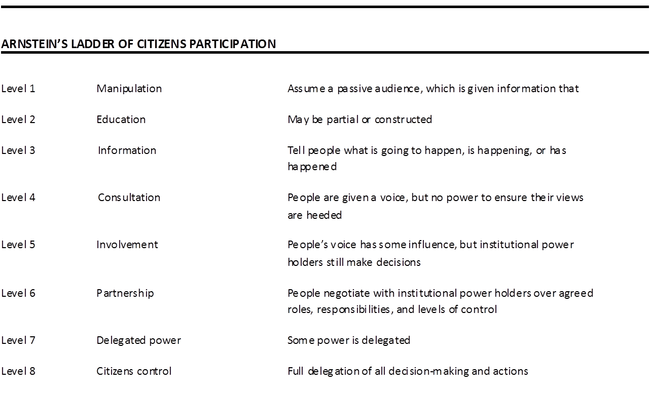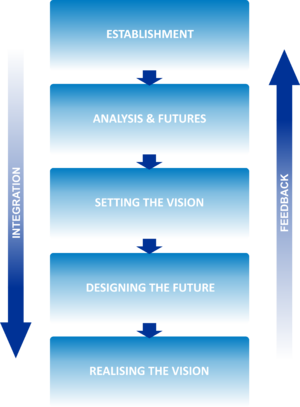PEGASO participation methods
Contents
What is Participation?
Public participation is widely recognised as a necessary tool to ensure a successful implementation of environmental policies: the Conference on Environment and Development (Earth Summit) in Rio de Janeiro in 1992, Principle 10 [1] and Agenda 21 [2] both called for increased public participation in environmental decision-making and led to the adoption in Europe of the Aarhus Convention [3]. Furthermore participation has become a fundamental pillar of environmental processes as described in the Water Framework Directive (2000/60/EC), the 2002 EU Recommendation on ICZM (2002/413/EC) and the Mediterranean Protocol on ICZM [4].
Participation can be defined as a process where individuals, groups and organisations choose to take an active role in making decisions that affect them [5]. Since the Conference on Environment and Development of 1992, public participation has been recognised as a necessary element of all environmental procedures like environmental assessment, local Agenda 21, and ICZM.
The most famous categorization of participation is the so called “Ladder of participation” (Arnstein, 1969 [6]). The categorization shows the different ways in which the organisation responsible for activity (e.g. an authority) can involve participants, in this case citizens.

|
| Fig. 1 : Arnstein’s ladder of citizen participation |
An effective participation process within environmental management brings several opportunities: it allows to obtain information that would not be available otherwise, it minimizes the uprising of conflicts and it leads to a greater quality and durability of decisions [7][8]. Furthermore, participation benefits include widening the representation of interests involved in decision-making, improving local “ownership” of strategies, having a positive impact on the legitimacy of policies and decision-making, ensuring that projects meet citizen’s needs [9].
Notwithstanding, stakeholder participation can also pose challenges. Involving stakeholders can be costly, time-consuming, labour-intensive, confrontational, and can ultimately delay development and implementation of policies. Additionally, if improperly managed, stakeholders participation can create new conflicts or escalate existing ones [10].
Participation for ICZM
Active public participation is an essential requirement of the ICZM process and should have first priority in the planning and in the review of coastal zone management decisions and actions [1][4][11][12]. For instance, article 14 of the Protocol on Integrated Coastal Management on the Mediterranean [4] foreseen the appropriate involvement of all stakeholders in the formulation and implementation of coastal and marine strategies, plans, programmes or projects in order to guarantee efficient governance of the ICZM process.
Who is a stakeholder?
As defined by Freeman (1984) [13] a stakeholder is who is affected by the decisions and actions taken by policy makers and who has the power to influence their outcome. Accordingly, understanding who should be involved and on which level within an environmental management process is a complex issue. It is very important to understand how different stakeholders are related to each other and how they are related to the resources to be managed.
The 2008 Protocol on ICZM in the Mediterranean devotes an entire article to the participation specifying who should be included in the participatory process. Article 14 of the Protocol states that:
- the territorial communities and public entities concerned;
- economic operators;
- non-governmental organizations;
- social actors;
- the public concerned.”
This Protocol article is meant to be put in practice in the PEGASO project. Participation should be tailored and adapted to the context and objectives of the CASES, and possibly integrated with other tools applied (e.g. indicators, scenarios).
The participation within ICZM phases for the CASES
In the PEGASO CASES participation is more than just a tool: it is a fundamental pillar of the process of ICZM development as well as a cross-cutting component of the integrated PEGASO tool box (e.g. indicators, scenarios). The development of an ICZM plan follows the 5 phases depicted in the following scheme. Although the phases of ICZM are presented here as steps it is worth to remind that ICZM is an iterative, continuous, proactive and flexible process.
Establishment
In the Establishment phase the main participatory objective is to ensure full engagement of stakeholders and the public in the plan process and its implementation. Moreover, in this phase is also important to apply participation in the identification of the coastal zone boundaries and in the analysis of the coastal zone according to the drivers and pressures.
Core questions of the ESTABLISHMENT phase
- Have you identified your coastal zone boundaries, drivers and pressures?
- Have you established an ICZM steering group including the main stakeholders of the area?
Participatory objective:
- To identify all the stakeholders for every end-product by means of a stakeholder analysis;
- To identify the coastal zone boundaries, drivers and pressures.
Suggested participatory methods
In order to carry on a stakeholder analysis different methods and approaches can be adopted:
- Expert panel
- Field trip
- Focus group
- Mediation and Negotiation principles
- Open space technology
- Snowball sampling
In order to carry on an analysis of the coastal boundaries, the drivers and pressures of the coastal zone the following method can be used: IMAGINE.
Analysis and futures
In the Analysis and futures phase the main participatory objective is to integrate in the analysis process and scenarios building all the local values and knowledge of stakeholders.
Core questions of the ANALYSIS AND FUTURES phase
- Have you developed an analysis process in order to gain objectives of the previous ICZM phase (e.g. maps, indicators)?
- Have you developed potential future situations by means of scenario building?
Participatory objective:
- To fully engage stakeholders in the discussion of the analysis and scenarios generating process
Suggested participatory methods
Setting the Vision
In the Setting the Vision phase the main participatory objective is to fully engage the stakeholders into the process. In this phase stakeholders should actively contribute to the identification of the coastal issues.
Core questions of SETTING THE VISION phase:
- Have you agreed with stakeholders on a set of ICZM objectives?
Participatory objective:
- To fully engage stakeholders in the definition of the coastal issues and priorities to deal with in the ICZM strategy.
Suggested participatory methods
- Brainstorming
- Future search conference
- Key stakeholder interviews
- Mediation and Negotiation principles
- Open Space Technology
Designing the future
In the Plan and adoption phase the main participatory objective is to involve stakeholders to review and amend the Plan that would then be adopted.
Core questions of DESIGNING THE FUTURE phase:
- Have you developed a shared action plan for ICZM implementation?
Participatory objective:
- To fully engage stakeholders in the definition, discussion and the review of the Plan.
Suggested participatory methods
Realising the Vision
In the Realising the Vision phase the participation moments could regard the monitoring and evaluation of the results of the strategy adopted.
Core questions of REALISING THE VISION phase:
- Have you realised concrete management actions as a result of an ICZM programme?
Suggested participatory methods
References
- ↑ 1.0 1.1 United Nations Conference on Environment and Development (UNCED) (1992). Rio Declaration on Environment and Development. The United Nations Conference on Environment and Development”, Rio de Janeiro 3-14 June 1992
- ↑ United Nations Conference on Environment and Development (UNCED) (1992). Agenda 21 United Nations, Rio de Janeiro. The United Nations Conference on Environment and Development”, Rio de Janeiro 3-14 June 1992.
- ↑ UN/ECE (1998). ‘Convention on Access to Information, Public Participation in Decision-Making and Access to Justice in Environmental Matters’ ECE Committee on Environmental Policy, Aarhus, pp. 28.
- ↑ 4.0 4.1 4.2 UNEP MAP, (2008). ICZM Protocol in the Mediterranean
- ↑ Reed M. S., Graves A., Dandy N., Posthumus H., Hubacek K., Morris J., Prell C., Quinn C. H., Stringen L. C. (2009). Who’s in and why? A typology of stakeholder analysis methods for natural resource management. In: Journal of Environmental Management 90, 1933–1949
- ↑ Arnstein S. R. (1969). A Ladder of Citizens Participation Journal of the American Institute of Planners 35:216-224)
- ↑ Santos R., Antunes P., Baptista G., Mateus P., Madruga L. (2006). Stakeholder participation in the design of environmental policy mixes. In: Ecological Economics 60, 100–110
- ↑ Reed M. S. (2008). Stakeholder participation for environmental management. A literature review. In: Biological Conservation 141, 2417–2431.
- ↑ Fletcher S. (2003). Stakeholder representation and the democratic basis of coastal partnerships in the UK. In: Marine Policy 27, 229–240
- ↑ NOAA Costal service center (2007). Introduction to stakeholder participation. In: www.csc.noaa.gov
- ↑ Stojanovic T., Ballinger C., Lalwani C. (2004). Successful integrated coastal management: measuring it with research and contributing to wise practice, Ocean & Coastal Management 47 (2004) 273–298.
- ↑ Edwards, S.D., Jones, P.J.S. and Nowell, D.E. (1997). Participation in coastal zone management initiatives a review and analysis of examples from the UK. Ocean and Coastal Management 36:143–165
- ↑ Freeman R. E., Strategic Management, a stakeholder approach ,1984, Boston, Pitman.
The article has been reviewed by Plan Bleu and PAP/RAC Please note that others may also have edited the contents of this article.
|

